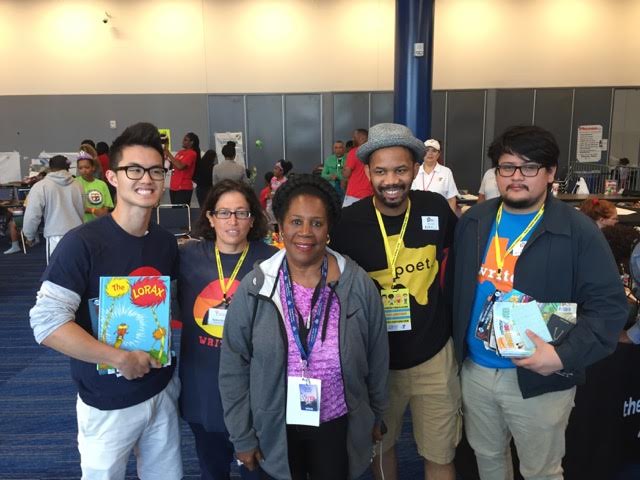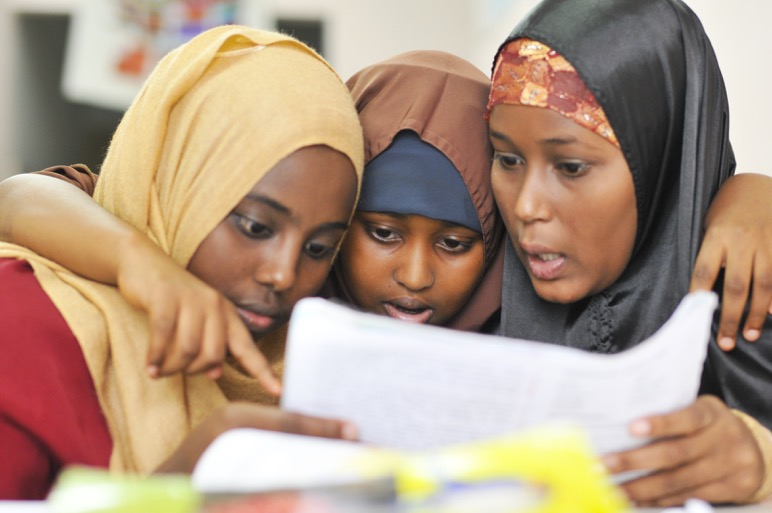Nicole Giannone shares their personal experience with training others in LGBTQ competency in the workplace. With a specific focus on Transgender and Gender Non-Confirming issues, much of the information that Nicole provides can also serve as actionable guidance for classroom teachers looking to create a safe and welcoming learning environment for all students.
I work at the Ali Forney Center (AFC) in New York City, the largest LGBT-specific center in the country for LGBTQ youth experiencing homelessness. I learned about AFC while in graduate school in 2009, but little did I know this organization would become my second home. The focus of this essay is to discuss the work I do around training others in LGBTQ competency. Though I came into this work as a member of the LGBTQ community, I still had so little information compared to what I have now. This knowledge can actually act as a barrier for me in my personal life, when I assume everybody knows what I know simply because they are in my life and I love them. The reality is, so many folks lack information about the LGBTQ community because this work is not part of their everyday experience. This is, unfortunately, damaging in many regards. Not only does a lack of information on the LGBTQ community hurt students in a teaching environment, but it impacts politics greatly. When will we finally have a government leader who will end homophobia and have the ability to educate more people on the matter better than I ever could? Misunderstanding is not always ignorance, but confusion. So the harm induced by many, including well-meaning teachers, is often unintentional.
Most people I’ve encountered through my work are genuinely interested in becoming competent around Transgender and Gender Non-Conforming (TGNC) issues. These people include those who provide direct service, such as caseworkers, financial advisors, real estate brokers, and physical therapists. Regardless of the professional relationship to TGNC clients, in my experience, most people want to be respectful of others’ individual identities.
From my perspective, the past few years seemed like a unique point in our culture around TGNC issues. More than any of its predecessors, the Obama Administration stood up for the LGBTQ community. Former Attorney General Loretta Lynch made a public promise to protect transgender Americans. Here in New York, Governor Cuomo issued regulations protecting New Yorkers based on their gender identity or gender expression, and the Human Rights Commission issued guidance around the NYC Human Rights Law that prohibits discrimination based on gender identity or gender expression. Even the United States Department of Housing and Urban Development issued the Equal Access Rule, providing guidance on how shelters should treat transgender people who are experiencing homelessness.
Despite all of the progress made, we still know that TGNC people are being murdered for simply living their truths. We know that they face discrimination in many settings, and because of this discrimination are more likely to attempt suicide or experience negative health outcomes. The unique moment in our culture seems to be at another turning point as we ease into the Trump Administration. The rescinding of Obama’s guidance to protect transgender students under Title IX, including guiding public schools around the nation to make transgender students use a bathroom based on their sex assigned at birth, was the first outright form of discrimination against TGNC children under the new Administration. This is the time to know your stuff so that you can stand up for, protect, and celebrate the TGNC students in your classrooms.
Sometimes, right alongside the need to understand, accept, and properly communicate with the TGNC community, comes immense fear and frustration. I see this dynamic play out at trainings I provide to corporate and nonprofit groups. It goes something like this:
Initial Inquiry from Company A: Hi! I am writing to you to see if you are able to provide a training on the transgenders. [It’s great the company is reaching out for help, but clearly “the transgenders” is incorrect. There is much to be learned!]
My response: Hello! Thank you for reaching out to the Ali Forney Center. We want more spaces to be safe for transgender individuals. Let’s set up a time to talk about the needs of your organization and plan a training.
At the training for Company A:
Me: Who in this room has a gender identity? [Everybody has one.]
Room: … [This isn’t a concept we are taught as children because we just assume everybody identifies as cisgender, or the way they were assigned at birth, so sometimes folks don’t know how to answer this question.]
Me: What pronouns do you use for yourself? I’m not asking what pronouns you prefer, because that would imply that using the pronoun you identify for yourself is optional for others.
Participant: I am a she.
Me: You can just say, “I use she/her pronouns.” Pronouns are not necessarily the same thing as your gender identity, though they match for many people.
What’s one thing you can take from today into your work?
Room: I’m scared I’m going to offend people, so I’m not going to say anything related to gender identity.
Me: People can initially feel confused and apprehensive because they do not want to say the “wrong thing.” However, practicing using language and terminology is crucial to being able to do it right in the future, so if you want to learn, you have to give it a try!
I like to use myself, as vulnerable as it sometimes makes me feel, to talk about “transgender awareness” with groups of people. I put quotation marks around this phrase somewhat ironically, because the community is complex and cannot be squeezed into a 90-minute training. I also understand that the first step towards competency is awareness. For example, as a white person, if I go to a training on the history of oppression against people of color in America, I don’t come out of that training being fully competent about this issue. I have gained awareness and it will likely propel me to learn more, observe more, and, ideally, make connections between the training and some of my implicit or explicit biases so that in my future interactions with people of color, I do not act in racist ways. I’m not yet fully competent, but I am connecting the dots of awareness to get to that point.
So, when I stand in front of a room of professionals as what some call “an expert,” I always use myself to teach. I tell the group that when I was born, a doctor assigned my sex as female and that I carry an “F” on all forms of my identification based on one examination of my newborn genitals. I tell them that as a child I always felt like a boy, but because my family, my church, my school, and my peers thought I was a girl, that is how I was raised. I tell them that I am not tormented by this history and that my parents not only had loose gender roles in general, but they let me do the things I liked, such as wear traditionally “boy” clothes, play sports, and be me.
I tell the training participants that there haven’t always been only two socially recognized genders for us to act out in America. Native Americans have historically recognized and even championed third-gender individuals or folks who identify as two-spirit. I remind training participants that gender in American culture in its current form results from histories of colonization, oppression, and marginalization. Because of that, many people are seen as “deviating” from traditional gender norms and therefore mistreated or misrepresented in mainstream culture.
I tell them that my parents named me Nicole and I like this name, but that it can confuse people because it’s traditionally feminine. I tell them that I use the gender-neutral pronouns they/them/theirs. I tell them that they probably assumed I was a woman when I walked into the room. I explain that assumptions are normal, but that the point of the training is to learn what to do next-because sometimes our assumptions are wrong. And sometimes our assumptions hurt others.
The complexity of our sex assignments, our gender identities, our gender presentations, and our gender expressions runs deep. Even this set of terms can really stress people out. Because of this, it is often at the expense of TGNC people that folks are not seeking out new information or new ways to communicate with a more gender-diverse group of people. Due to the isolation and marginalization many people in the TGNC community experience, we have figured out ways to have our own lives outside of mainstream culture, to the degree that in some places people are shocked that we exist! They never see us! Or, we are too scared to be who we are in mainstream settings because we can lose our housing, our jobs, our families, our partners, and our lives.
At the end of a training with a community group, corporate or otherwise, I want folks in the room to be able to:
- Understand what the word cisgender means and how they can use this term to describe themselves or their peers instead of only using the label transgender to describe someone that is “other” or “not like us.”
- Understand what the word transgender
- Realize that they, too, have both a gender identity and a sexual orientation, even if those are cisgender and straight.
- Acknowledge that they, too, have pronouns they use for themselves.
- Use gender-neutral pronouns they/their/them correctly in a sentence.
- Recognize that assuming how somebody identifies their gender based on the way they present is wrapped up within a social construct that we have learned. There are many examples of this, but to simplify it: someone with breasts might be a man, someone with a deep voice might be a woman, and there are many folks living in the middle of the traditional gender binary.
I also share other tips for how to raise awareness and make space for the TGNC community. In a professional setting, if you need to interact with someone, you’ll want to know their name and their pronouns to be able to communicate effectively and respectfully with them. For example:
- When someone comes into your space and has to fill out paperwork, you always want to provide space to write a name that might not be their legal name.
- Similarly, you want to allow them to choose a gender other than Male or Female.
- If you are really interested in creating safe spaces, you would even allow them to choose their pronoun so that if you feel scared to ask, you have it all on paper and can refer to that before interacting with the person.
While the trainings I lead take place in a business or nonprofit setting, these tips can all be translated to the education system. In order for our workplaces and schools to become truly inclusive and safe, we must:
- Commit to learning some basic information.
- Examine our discomfort or confusion.
- Engage with the information we are receiving now and leave behind old information we learned previously that is no longer accurate.
- Educate ourselves on the experiences of transgender and gender non-conforming people who live in our communities. Because in order for us to truly see TGNC people for who they are, we must believe that TGNC people are who they say they are.
TGNC people are sometimes okay being available to help people outside of the experience understand certain things, but TGNC people cannot always be our teachers. There are so many resources out there, from the Transgender Training Institute to online resources like Gender Spectrum. When it comes to helping people learn about the TGNC community, no longer will “I had no way of knowing” be a reasonable excuse. In order to prevent any child from experiencing homelessness, bullying at school, or the myriad of negative disparities that LGBTQ youth face, we must create spaces in our lives for young people to be who they are, safe in their presentations and in their identities. And it’s up to each one of us to start learning the basics about the TGNC community. I hope you’ll join me.
Read More: Work written by two Ali Forney Center clients-Zee and Maddox.
Nicole Giannone has been at the Ali Forney Center since 2010, initially getting involved as a volunteer before moving into the agency as a program assistant. Eventually, Nicole gained experience as a case manager, overnight supervisor, and coordinator of evaluation and contracts. They currently acts as director of program evaluation, training, and advocacy.



